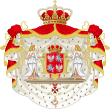This article includes a list of references, related reading, or external links, but its sources remain unclear because it lacks inline citations. (February 2020) |
This article relies largely or entirely on a single source. (June 2024) |
| Grand Chancellor of the Crown | |
|---|---|
 | |
| Residence | Kraków Warsaw |
| Appointer | Monarch of Poland Polish Parliament (Sejm) |
| Formation | 12th century |
| First holder | Jan? Goswin |
| Final holder | Antoni Sułkowski |
| Abolished | 1795 |
The Chancellor of Poland (Polish: Kanclerz - Polish pronunciation: [ˈkant͡slɛʂ], from Latin: cancellarius), officially, the Grand Chancellor of the Crown between 1385 and 1795, was one of the highest officials in the historic Crown of the Kingdom of Poland. This office functioned from the early Polish kingdom of the 12th century until the end of the Polish–Lithuanian Commonwealth in 1795. A respective office also existed in the Grand Duchy of Lithuania since the 16th century. Today the office of the chancellor has been replaced by that of the Prime Minister.
The Chancellors' powers rose together with the increasing importance of written documents. In the 14th century the office of Chancellor of Kraków (Polish: Kanclerz krakowski) evolved into the Chancellor of the Crown (Polish: Kanclerz koronny) and from that period the chancellor powers were greatly increased, as they became responsible for the foreign policy of the entire Kingdom (later, the Commonwealth). The Chancellor was also supposed to ensure the legality of monarch's actions, especially whether or not they could be considered illegal in the context of pacta conventa (an early set of documents containing important laws, in some aspects resembling today's constitutions). Finally, the Chancellor was also responsible for his office, the chancellery (Polish: kancelaria). A 16th-century Polish lawyer, Jakub Przybylski, described the Chancellor as the king's hand, eye and ear, translator of his thoughts and will.
From 15th century onward there were two separate Chancellor offices, neither of them subordinate to the other: Grand Chancellor (Polish: Kanclerz wielki) and Vice-Chancellor (Polish: Podkanclerzy). In the Polish-Lithuanian Commonwealth, there were four Chancellors: Grand Chancellor of the Crown (Polish: Kanclerz wielki koronny), Grand Chancellor of Lithuania (Polish: Kanclerz wielki litewski), Vice-Chancellor of the Crown (Polish: Podkanclerzy koronny), and Vice-Chancellor of Lithuania (Polish: Podkanclerzy litewski).
